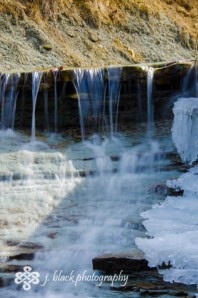Home » Posts tagged 'Aperture'
Tag Archives: Aperture
Depth of Field/Motion and Freezing Motion (Aperture and Shutter Speeds)
Well this is becoming the most challenging week up to date in school for me. I was very familiar with Aperture and Shutter Speeds before this week but actually applying them correctly…..apparently not. The first assignment this week was two part. The first part was to find a scene that had foreground (1-3 feet away from camera), a middle ground (3-7 feet from camera) and a background (10-20 feet from camera), keeping in mind elements of composition (rule of thirds, shape, line, pattern). I spent hours trying to find a scene to fit the above description (it is winter and everything is pretty much brown or gray). I finally found a spot about 10 minutes from the house which is funny when you consider all the gas I wasted looking for the perfect scene. Once I found a spot I had to take 15 shots of the same scene with different Apertures (f-stops), remembering that I had to have a good exposure, so each time I would adjust the aperture, the shutter speed would have to be adjusted accordingly.
I do not know how many of you shoot in manual mode, but for those that don’t a quick explanation. Aperture is the diameter of the lens in your camera. A large aperture (small f-stop number) lets in more light and small aperture (large f-stop number) lets in less light. Apertures range from f1.4, f1,8, f 2.8, f4, f5.6, f8, f11, f16, f22, f36 and may vary from camera to camera. Aperture varies with each lens as well.
Take a look at a few shots with different apertures and see the difference.
There is quite a bit of difference from f 2.8 to f 22. The focus is very limited at f 2.8, only the stone wall is in focus and at f 22 everything is in focus. I used the stone wall as my focus point throughout all the images.
The next part of the assignment was shutter speed. Shutter speeds control the time that the lens is open and letting light through the lens. Shutter speeeds range from 1/8000 of a second to 30 seconds depending on the camera. ( Quick tip..anything shutter speed slower than 1/30 of a second needs to be placed on a tripod to avoid blur.) A slow shutter speed will blur motion (1/4 second, 1 second, 2 seconds and so on). A fast shutter speed will freeze motion (1/250, 1/400, 1/1000, 1/4000 and so on). This part of the assignment was the same as the aperture just using shutter speed as a priority, trying to freeze motion and or blur motion. I found a small waterfall again right down the road from where I live and again after driving for hours to find the perfect spot of water flowing. I went all out, I stood in the water (it was 30 degrees outside) with my tripod and camera, got down low and starting shooting. Below are a couple examples of the results.
If you notice at 1/4 second the water is dreamy and blurred and at 1/160 of a second it is frozen. This is the difference in shutter speeds. This was a very challenging assignment and enjoyable all at the same time. I learned a lot. I learned that if it is very sunny outside, you cannot slow your shutter speed as much as you would like without using a neutral density filter (another blog for another time). I also learned that varying your apertures and shutter speeds can have very different dramatic effects on your photos. It can change the emotion of what you are trying to capture completely. So if you have time go out and try it. Find an interesting spot that you can do the above assignment and see what you can create. You will be amazed at the outcome. I was.









